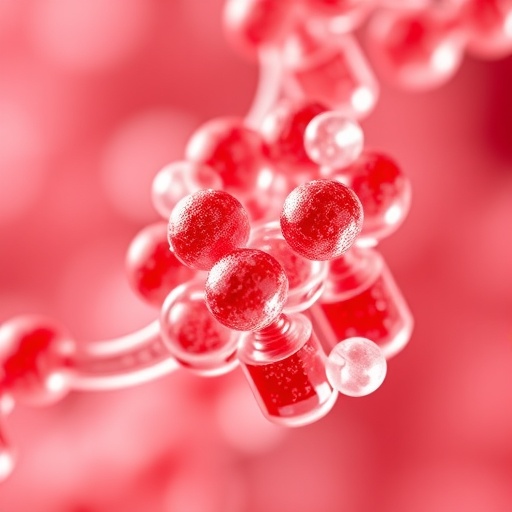In a groundbreaking study from Tohoku University, researchers have uncovered a crucial temperature-dependent mechanism that governs the efficiency and stability of RhRu₃Oₓ catalysts during the oxygen evolution reaction (OER) in acidic environments. This discovery paves the way for next-generation electrochemical devices by significantly enhancing catalyst durability and performance, two longstanding challenges in the field of sustainable energy technology.
The oxygen evolution reaction is integral to various electrochemical systems, notably in water splitting for hydrogen production and in rechargeable batteries. Despite its importance, the OER is notoriously sluggish and demands advanced catalysts to lower the substantial energy barrier required. Traditionally, precious metal oxides like RuO₂ have been used, but their limited stability and high costs pose a bottleneck. The introduction of RhRu₃Oₓ offers a promising alternative, enabling high catalytic activity without succumbing to rapid degradation.
Utilizing a custom-designed operando differential electrochemical mass spectrometry system, the research team conducted in situ investigations to monitor the behavior of RhRu₃Oₓ under realistic operating conditions. This sophisticated approach allowed the scientists to track reaction intermediates and key electrochemical parameters dynamically, offering unprecedented insights into the catalyst’s response to temperature fluctuations during OER.
One of the most compelling findings from this study is the temperature-dependent mechanism evolution, indicating that the OER proceeds via distinct pathways at different temperature regimes. At lower temperatures, the catalytic cycle favors one reaction mechanism, whereas at elevated temperatures, an alternative pathway becomes dominant. This duality underscores the complexity of the catalytic process and highlights temperature as a critical variable influencing catalyst performance.
This temperature-triggered shift in reaction mechanism profoundly impacts the catalyst’s stability, a detail often overlooked in prior investigations. With RhRu₃Oₓ, the research demonstrated remarkable longevity, maintaining stable operation for over 1000 hours at room temperature under a substantial current density of 200 mA cm⁻². Such durability is a milestone for acidic OER catalysts, which typically degrade much faster under similar conditions.
The team’s electrochemical impedance spectroscopy (EIS) and linear sweep voltammetry (LSV) measurements revealed nuanced differences between RhRu₃Oₓ and conventional ruthenium dioxide catalysts. The impedance data, particularly Nyquist plots, highlighted reduced charge transfer resistance in RhRu₃Oₓ, which is attributed to superior electronic conductivity and optimized surface properties. These electrical characteristics contribute significantly to the enhanced catalytic activity observed.
Further characterization involved cyclic voltammetry (CV) to estimate the electrochemically active surface area (ECSA) via double-layer capacitance (C_dl). RhRu₃Oₓ exhibited a larger C_dl value compared to homogenous and commercial RuO₂ catalysts, indicating a higher density of active sites accessible for OER. This increased surface area is vital for maximizing reaction rates and minimizing energy losses during water oxidation.
The research team also systematically explored the impact of temperature on the kinetics of the OER through Tafel analysis. By deriving Tafel slopes at varying temperatures, they quantified changes in the rate-determining steps and electron transfer dynamics within the catalyst. An Arrhenius plot of exchange current density reinforced the conclusion that temperature modulates the activation energy barrier for OER, thereby influencing the overall efficiency of RhRu₃Oₓ.
Looking ahead, the study envisions the deliberate tuning of fluorine doping levels within the catalyst matrix as a promising strategy to further boost performance. Fluorine doping is expected to strengthen the catalyst’s electronic structure and enhance its resistance to acidic corrosion, thus enabling stable operation under the demanding conditions typical of proton exchange membrane (PEM) electrolyzers deployed in commercial hydrogen production.
This breakthrough contributes significantly to the fundamental understanding of transition metal phosphides (TMPs) and related catalysts for hydrogen evolution and oxygen evolution reactions. By elucidating the temperature-dependent reaction mechanisms, the findings chart a clear path toward the rational design of efficient, long-lasting, and economically viable catalysts crucial for green energy technologies.
In the broader context of materials science and electrochemistry, such insights are invaluable. Achieving stable and efficient catalysts for the OER is a prerequisite for scalable water electrolysis, a front-runner technology for clean hydrogen fuel production. The RhRu₃Oₓ catalyst, with its dual-mechanism adaptability and exceptional endurance, represents a leap forward in this endeavor.
Moreover, the integration of advanced spectroscopic methodologies with electrochemical testing in this study exemplifies a modern, holistic approach to catalyst development. Real-time operando analysis bridges the gap between theoretical predictions and practical performance, enabling researchers to decode complex reaction pathways and design smarter catalysts.
As the global energy landscape rapidly shifts toward sustainable alternatives, innovations like these are critical. They reduce reliance on fossil fuels by facilitating efficient water splitting processes that generate hydrogen, thereby offering a clean and renewable energy carrier. The implications extend from improving battery technologies to advancing hydrogen fuel cells and beyond.
This landmark research, published in Nature Communications, not only sheds light on the fundamental science underpinning catalyst behavior but also delivers actionable insights for the deployment of OER catalysts in real-world applications. By harnessing the temperature-dependent reaction pathways inherent to RhRu₃Oₓ, the future of electrochemical energy conversion could become more efficient, affordable, and sustainable.
Subject of Research: Oxygen evolution reaction catalysis, catalyst stability, and temperature-dependent reaction mechanisms
Article Title: Researchers Find That Temperature Matters for RhRu₃Ox During Acidic Water Oxidation
News Publication Date: 20-Oct-2025
Web References:
– https://dx.doi.org/10.1038/s41467-025-64286-1
Image Credits: ©Heng Liu et al.
Keywords
Water oxidation, Electrochemistry, Mass spectrometry, Materials science, Catalysis




